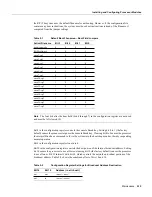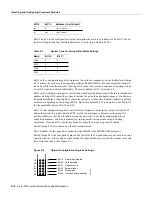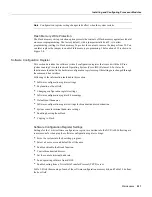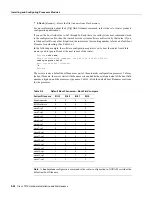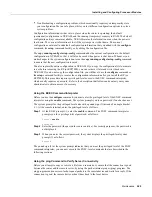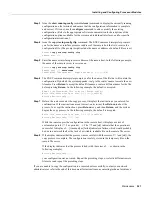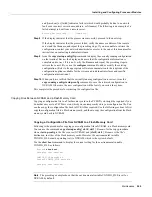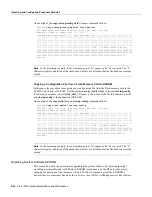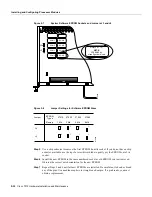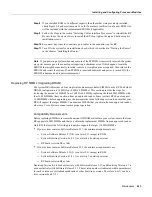
Maintenance 5-19
Installing and Configuring Processor Modules
Router> enable
Password:
router#
Step 2
At the privileged-level system prompt (router #), enter the command
configure terminal.
You will be prompted as shown in the following example:
Router# conf term
Enter configuration commands, one per line. End with CTRL/Z
Step 3
To set the contents of the configuration register, enter the config-register value
configuration command where value is a hexadecimal number preceded by 0x (see
Table 5-4), as in the following:
config-register 0xvalue
Step 4
Exit the configuration mode by entering Ctrl-Z. The new value settings will be saved to
memory; however, the new settings do not take effect until the system software is reloaded
by rebooting the router.
Step 5
To display the configuration register value currently in effect and the value that will be used
at the next reload, enter the show version EXEC command. The value will be displayed on
the last line of the screen display, as in the example following:
Configuration register is 0x141 (will be 0x101 at next reload)
Step 6
Reboot the router. The new value takes effect. Configuration register changes take effect
only when the server restarts, such as when you switch the power OFF and on or when you
issue a reload command from the console.
If the boot ROMs do not support the software configuration register (not Release 10.0 or
later), the following message will be displayed:
Boot ROMs do not support software configuration register.
Value not written to NVRAM.
Bit Meanings
The lowest four bits of the software configuration register (bits 3, 2, 1, and 0) form the boot field.
(See Table 5-5.) The boot field specifies a number in binary form. If you set the boot field value to
0, you must boot the operating system manually by entering the b command at the bootstrap prompt
as follows:
> b [tftp] flash filename
Definitions of the various b command options follow:
•
b—Boots the default system software from ROM
Note
The RSP7000 does not use ROM devices to run Cisco IOS images.
•
b flash—Boots the first file in Flash memory
•
b slot0: filename—Boots the file filename from the Flash memory card in the PCMCIA Slot on
the faceplate
•
b filename [host]—Netboots using TFTP
Содержание TelePresence Server 7010
Страница 10: ...x Cisco 7010 Hardware Installation and Maintenence ...
Страница 14: ...iv Cisco 7010 Hardware Installation and Maintenance Document Conventions ...
Страница 112: ...2 52 Cisco 7010 Hardware Installation and Maintenance Initial Configuration Information Page ________ ...
Страница 148: ...3 36 Cisco 7010 Hardware Installation and Maintenance Using the Flash Memory Card ...
Страница 158: ...4 10 Cisco 7010 Hardware Installation and Maintenance Troubleshooting the Processor Subsystem ...
Страница 242: ...5 84 Cisco 7010 Hardware Installation and Maintenance Replacing Internal Components ...
Страница 258: ...A 16 Cisco 7010 Hardware Installation and Maintenance MIP Interface Cable Pinouts ...
Страница 270: ...B 12 Cisco 7010 Hardware Installation and Maintenance Interface Processor LEDs ...
Страница 274: ...C 4 Cisco 7000 Hardware Installation and Maintenance ...
Страница 287: ...Index 13 ...











